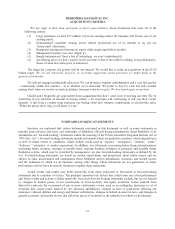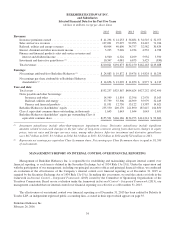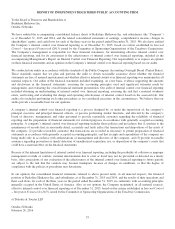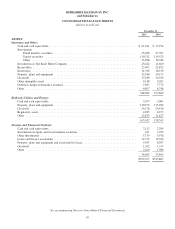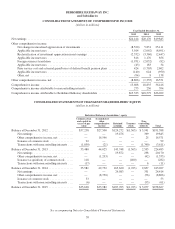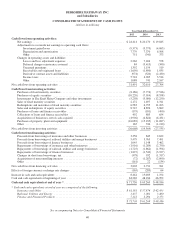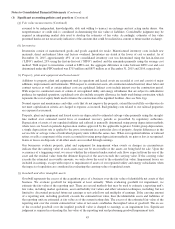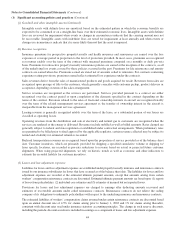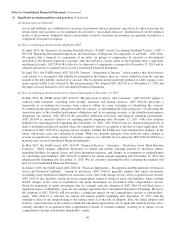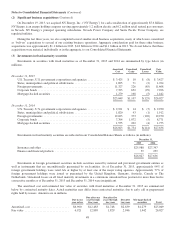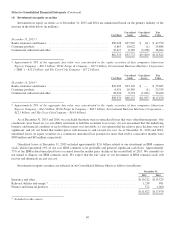Berkshire Hathaway 2015 Annual Report Download - page 43
Download and view the complete annual report
Please find page 43 of the 2015 Berkshire Hathaway annual report below. You can navigate through the pages in the report by either clicking on the pages listed below, or by using the keyword search tool below to find specific information within the annual report.BERKSHIRE HATHAWAY INC.
and Subsidiaries
NOTES TO CONSOLIDATED FINANCIAL STATEMENTS
December 31, 2015
(1) Significant accounting policies and practices
(a) Nature of operations and basis of consolidation
Berkshire Hathaway Inc. (“Berkshire”) is a holding company owning subsidiaries engaged in a number of diverse
business activities, including insurance and reinsurance, freight rail transportation, utilities and energy, manufacturing,
service, retailing and finance. In these notes the terms “us,” “we,” or “our” refer to Berkshire and its consolidated
subsidiaries. Further information regarding our reportable business segments is contained in Note 23. Significant
business acquisitions completed over the past three years are discussed in Note 2.
The accompanying Consolidated Financial Statements include the accounts of Berkshire consolidated with the accounts of
all subsidiaries and affiliates in which we hold a controlling financial interest as of the financial statement date. Normally
a controlling financial interest reflects ownership of a majority of the voting interests. We consolidate a variable interest
entity (“VIE”) when we possess both the power to direct the activities of the VIE that most significantly impact its
economic performance and we are either obligated to absorb the losses that could potentially be significant to the VIE or
we hold the right to receive benefits from the VIE that could potentially be significant to the VIE.
Intercompany accounts and transactions have been eliminated.
(b) Use of estimates in preparation of financial statements
The preparation of our Consolidated Financial Statements in conformity with accounting principles generally accepted
in the United States (“GAAP”) requires us to make estimates and assumptions that affect the reported amounts of
assets and liabilities at the date of the financial statements and the reported amounts of revenues and expenses during
the period. In particular, estimates of unpaid losses and loss adjustment expenses and related recoverables under
reinsurance for property and casualty insurance are subject to considerable estimation error due to the inherent
uncertainty in projecting ultimate claim amounts. In addition, estimates and assumptions associated with the
amortization of deferred charges on retroactive reinsurance contracts, determinations of fair values of certain financial
instruments and evaluations of goodwill and identifiable intangible assets for impairment require considerable
judgment. Actual results may differ from the estimates used in preparing our Consolidated Financial Statements.
(c) Cash and cash equivalents
Cash equivalents consist of funds invested in U.S. Treasury Bills, money market accounts, demand deposits and other
investments with a maturity of three months or less when purchased.
(d) Investments
We determine the appropriate classification of investments in fixed maturity and equity securities at the acquisition date
and re-evaluate the classification at each balance sheet date. Held-to-maturity investments are carried at amortized cost,
reflecting the ability and intent to hold the securities to maturity. Trading investments are securities acquired with the
intent to sell in the near term and are carried at fair value. All other securities are classified as available-for-sale and are
carried at fair value with net unrealized gains or losses reported as a component of accumulated other comprehensive
income. Substantially all of our investments in equity and fixed maturity securities are classified as available-for-sale.
We utilize the equity method to account for investments when we possess the ability to exercise significant influence,
but not control, over the operating and financial policies of the investee. The ability to exercise significant influence is
presumed when an investor possesses more than 20% of the voting interests of the investee. This presumption may be
overcome based on specific facts and circumstances that demonstrate that the ability to exercise significant influence is
restricted. We apply the equity method to investments in common stock and to other investments when such other
investments possess substantially identical subordinated interests to common stock.
In applying the equity method, we record the investment at cost and subsequently increase or decrease the carrying
amount of the investment by our proportionate share of the net earnings or losses and other comprehensive income of
the investee. We record dividends or other equity distributions as reductions in the carrying value of the investment. In
the event that net losses of the investee reduce the carrying amount to zero, additional net losses may be recorded if
other investments in the investee are at-risk, even if we have not committed to provide financial support to the investee.
Such additional equity method losses, if any, are based upon the change in our claim on the investee’s book value.
41



